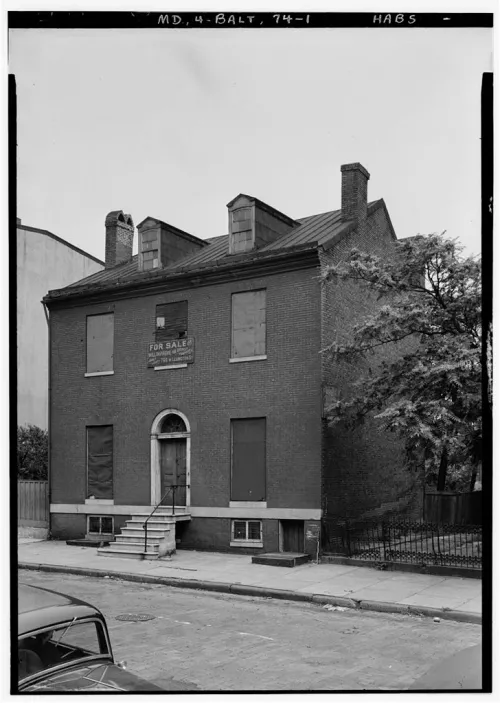Share what you know,
and discover more.
Share what you know,
and discover more.
Nov 11, 1971

-

- Charmaine Bantugan
National Register of Historic Places - Edgar Allan Poe (Clemm-Poe House)
Statement of Significant: Edgar Allan Poe has been called "one of the very few great innovators in American literature." He created a body of poems of timeless value and great historical significance. Through Baudelaire, for example, he cast a formative influence on French Symbolism, which in turn enriched the work of such American poets as T. S. Eliot. As a prose writer, Poe virtually invented the detective story, and his tales helped to spawn other popular genres as well as affecting such profound writers as Dostoievski.3 He was also a brilliant critic, and propounded literary theories which continue to command respect. As Arthur Hobson Quinn has written, Poe was "the one writer in the English language, who was at once foremost in criticism, supreme in fiction, and in poetry destined to be immortal." Poe lived in the house at 203 Amity Street with his paternal grandmother, his aunt, Maria Clemm, and her daughter, Virginia, whom the poet later married. This family group was definitely living in the house in the spring of 1833, and perhaps were there as early as the previous spring; Poe himself remained here until the summer of 1835, when he departed for Richmond. During his period in Amity Street, he is said to have accomplished the works numbered seven to twelve in the collection of his writings edited by Arthur Hobson Quinn.6 It was during this period that Poe's prose tales began to attract attention, and the Amity Street house is also presumed to be the scene of his courtship of Virginia. The house possesses a high degree of integrity, and memorializes an important phase in the career of one of America's greatest writers.
National Register of Historic Places - Edgar Allan Poe (Clemm-Poe House)
Statement of Significant: Edgar Allan Poe has been called "one of the very few great innovators in American literature." He created a body of poems of timeless value and great historical significance. Through Baudelaire, for example, he cast a formative influence on French Symbolism, which in turn enriched the work of such American poets as T. S. Eliot. As a prose writer, Poe virtually invented the detective story, and his tales helped to spawn other popular genres as well as affecting such profound writers as Dostoievski.3 He was also a brilliant critic, and propounded literary theories which continue to command respect. As Arthur Hobson Quinn has written, Poe was "the one writer in the English language, who was at once foremost in criticism, supreme in fiction, and in poetry destined to be immortal." Poe lived in the house at 203 Amity Street with his paternal grandmother, his aunt, Maria Clemm, and her daughter, Virginia, whom the poet later married. This family group was definitely living in the house in the spring of 1833, and perhaps were there as early as the previous spring; Poe himself remained here until the summer of 1835, when he departed for Richmond. During his period in Amity Street, he is said to have accomplished the works numbered seven to twelve in the collection of his writings edited by Arthur Hobson Quinn.6 It was during this period that Poe's prose tales began to attract attention, and the Amity Street house is also presumed to be the scene of his courtship of Virginia. The house possesses a high degree of integrity, and memorializes an important phase in the career of one of America's greatest writers.
Nov 11, 1971
National Register of Historic Places - Edgar Allan Poe (Clemm-Poe House)
Statement of Significant:Edgar Allan Poe has been called "one of the very few great innovators in American literature." He created a body of poems of timeless value and great historical significance. Through Baudelaire, for example, he cast a formative influence on French Symbolism, which in turn enriched the work of such American poets as T. S. Eliot. As a prose writer, Poe virtually invented the detective story, and his tales helped to spawn other popular genres as well as affecting such profound writers as Dostoievski.3 He was also a brilliant critic, and propounded literary theories which continue to command respect. As Arthur Hobson Quinn has written, Poe was "the one writer in the English language, who was at once foremost in criticism, supreme in fiction, and in poetry destined to be immortal."
Poe lived in the house at 203 Amity Street with his paternal grandmother, his aunt, Maria Clemm, and her daughter, Virginia, whom the poet later married. This family group was definitely living in the house in the spring of 1833, and perhaps were there as early as the previous spring; Poe himself remained here until the summer of 1835, when he departed for Richmond. During his period in Amity Street, he is said to have accomplished the works numbered seven to twelve in the collection of his writings edited by Arthur Hobson Quinn.6 It was during this period that Poe's prose tales began to attract attention, and the Amity Street house is also presumed to be the scene of his courtship of Virginia. The house possesses a high degree of integrity, and memorializes an important phase in the career of one of America's greatest writers.
Posted Date
Aug 15, 2023
Historical Record Date
Nov 11, 1971
Source Name
National Register of Historic Places
Source Website
Delete Story
Are you sure you want to delete this story?












